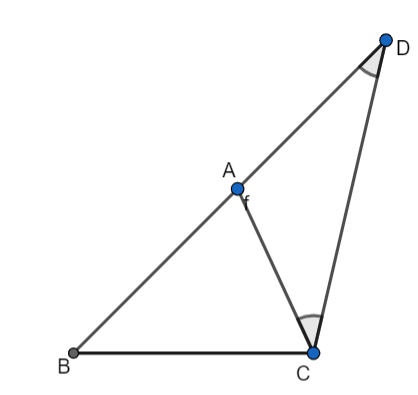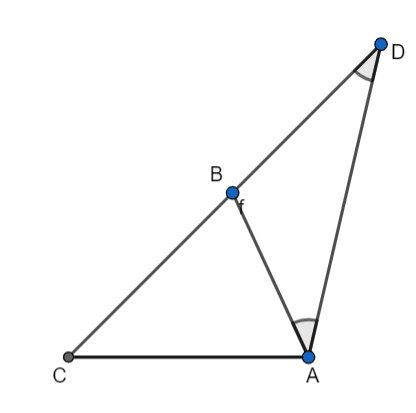
The sum of lengths of any two sides of a triangle is always ………………………….the third side.
A.Greater than
B.Less than
C.Equal to
D.None of these
Answer
591.9k+ views
Hint: Assume a \[\Delta ABC\] and then extend the side BA to D such that \[AD=AC\] . If two sides are equal then the angles opposite to them are also equal. So, \[\angle ADC=\angle ACD\] . In the \[\Delta BCD\] , we have \[\angle BCD>\angle ACD\], but \[\angle ADC=\angle ACD\]. So, \[\angle BCD>\angle ADC\] . We know the theorem that the side opposite to the larger angle is longer. So, \[BD>BC\] . BD is the summation of the side AB and AD. But we have \[AD=AC\] . Now, solve it further.
Complete step-by-step answer:

First of all, let us assume a \[\Delta ABC\]and then extend the side BA to D such that \[AD=AC\] . Now, join D to C.
In the \[\Delta ADC\] , we have \[AD=AC\] ……………….(1)
We know the theorem that the angles opposite to equal sides are also equal.
We have \[\angle ADC\] and \[\angle ACD\]opposite to the sides AD and AC respectively.
So, \[\angle ADC=\angle ACD\] ………………….(2)
In the \[\Delta BCD\] we have,
\[\angle BCD=\angle ACD+\angle ACB\] …………………..(3)
From equation (2) and equation (3), we get
\[\angle BCD=\angle ADC+\angle ACB\]
Thus, we can write \[\angle BCD>\angle ADC\] .
We know the theorem that the side opposite to the larger angle is longer.
We have the side BD and BC opposite to the angles \[\angle BCD\] and \[\angle ADC\] respectively.
So, \[BD>BC\] ……………..(4)
From the figure, we can see that the side BD is the summation of the side BA and AD.
Transforming equation (4), we get
\[BD>BC\]
\[BA+AD>BC\] ……………………..(5)
From equation (1) and equation (5), we get
\[BA+AC>BC\] .
The summation of the two sides is greater than the third side.
Hence, option (A) is the correct option.
Note: In this question, one may think that why only the side BA is extended to D. The answer for this is we can extend any side to D but we have to take one side equal to the other side. Let us understand with an example.

Here, we are extending the side CB to D such that AB=BD. Now using the same approach, solve this.
Complete step-by-step answer:

First of all, let us assume a \[\Delta ABC\]and then extend the side BA to D such that \[AD=AC\] . Now, join D to C.
In the \[\Delta ADC\] , we have \[AD=AC\] ……………….(1)
We know the theorem that the angles opposite to equal sides are also equal.
We have \[\angle ADC\] and \[\angle ACD\]opposite to the sides AD and AC respectively.
So, \[\angle ADC=\angle ACD\] ………………….(2)
In the \[\Delta BCD\] we have,
\[\angle BCD=\angle ACD+\angle ACB\] …………………..(3)
From equation (2) and equation (3), we get
\[\angle BCD=\angle ADC+\angle ACB\]
Thus, we can write \[\angle BCD>\angle ADC\] .
We know the theorem that the side opposite to the larger angle is longer.
We have the side BD and BC opposite to the angles \[\angle BCD\] and \[\angle ADC\] respectively.
So, \[BD>BC\] ……………..(4)
From the figure, we can see that the side BD is the summation of the side BA and AD.
Transforming equation (4), we get
\[BD>BC\]
\[BA+AD>BC\] ……………………..(5)
From equation (1) and equation (5), we get
\[BA+AC>BC\] .
The summation of the two sides is greater than the third side.
Hence, option (A) is the correct option.
Note: In this question, one may think that why only the side BA is extended to D. The answer for this is we can extend any side to D but we have to take one side equal to the other side. Let us understand with an example.

Here, we are extending the side CB to D such that AB=BD. Now using the same approach, solve this.
Recently Updated Pages
Master Class 9 Social Science: Engaging Questions & Answers for Success

Master Class 9 Science: Engaging Questions & Answers for Success

Master Class 9 English: Engaging Questions & Answers for Success

Master Class 9 Maths: Engaging Questions & Answers for Success

Master Class 9 General Knowledge: Engaging Questions & Answers for Success

Class 9 Question and Answer - Your Ultimate Solutions Guide

Trending doubts
Which places in India experience sunrise first and class 9 social science CBSE

Fill the blanks with the suitable prepositions 1 The class 9 english CBSE

Write the 6 fundamental rights of India and explain in detail

Difference Between Plant Cell and Animal Cell

What is pollution? How many types of pollution? Define it

What is the Full Form of ISI and RAW




